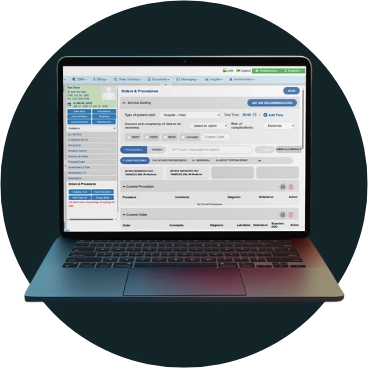Key Takeaways
- AI is already reshaping ENT practice management. Success depends on choosing tools that integrate smoothly and deliver measurable improvements.
- Automation reduces burnout and billing errors, freeing providers to focus on patient care and accurate documentation.
- ENT-Cloud’s All In Intelligence represents the next generation of AI in healthcare: intelligent workflows built by physicians to eliminate the barriers that keep doctors from care.
- Learn more about how All In Intelligence helps ENT practices work smarter.
Artificial intelligence is becoming part of daily life in nearly every field—and ENT is no exception. From scheduling and coding to patient documentation, AI is transforming how otolaryngologists manage their workflows.
Still, with rapid adoption comes uncertainty. Which tools actually help private practices? How much disruption is too much? And what’s just marketing dressed up as innovation?
During AI in Medical Practices: What Works and What’s Just Hype, Dr. Michael Dunn, CEO of Gateway Urgent Care and board member of the Arizona Medical Association, joined Adam Finzen, DPM, Director of Business Development at WRS Health, to help providers navigate the fast-changing AI landscape.
The discussion focused on the technologies delivering real return on investment, the pitfalls to avoid, and why meaningful AI in ENT begins with workflow design that reflects how providers really work.
Table of Contents
1. The ENT AI Market Is Booming—But Not Everything Delivers Value
AI has reached a critical point in otolaryngology. According to a 2025 survey of 43 U.S. health systems, every organization had adopted an ambient AI tool for clinical documentation, but only 53% reported strong success.
Many of these systems are built for hospitals, not specialty or private practices. Others require separate logins, high subscription fees, or interrupt established workflows. Instead of saving time, they often make care delivery more complicated.
Put It Into Practice:
Evaluate AI solutions based on tangible results—time saved, fewer errors, and measurable efficiency gains. The best tools integrate directly into your EHR. If you can’t see a clear benefit during the demo, it’s worth reconsidering.
2. ENT Practices Need AI to Stay Competitive
AI for ENT isn’t a luxury anymore—it’s quickly becoming a necessity. Payers are already using AI to downcode and pre-screen claims, shifting leverage away from practices. To compete, clinicians must match that level of efficiency.
Dr. Dunn pointed out that practices using AI for coding assistance, claim preparation, and pre-encounter documentation are seeing faster reimbursements and fewer denials. Automation of pre-visit tasks and audit-ready documentation helps ENT specialists recover valuable time and maintain revenue stability.
Put It Into Practice:
Look at your most time-consuming administrative tasks—documentation, coding checks, eligibility verification. Start implementing AI there, where the payoff will be fastest and most visible.
3. What’s Actually Working Right Now
Meaningful progress with AI in medicine isn’t coming from large, one-size-fits-all platforms. It’s happening through focused, task-driven tools that solve specific problems.
- Ambient listening (AI Scribes): Automatically capture visit notes through secure, real-time transcription, reducing documentation time.
- Coding Assistants: Recommend codes based on documented care, improving accuracy and compliance.
- AI Search and Summaries: Quickly surface relevant details from incoming CCDAs and external records, giving providers the data they need in seconds.
- Mobile AI Apps: Extend secure access to charts, telehealth sessions, and prescribing tools.
- Patient Intake Assistants: Streamline registration by guiding patients through digital forms before appointments.
Integration, Dunn emphasized, is what separates success from frustration. AI that works directly inside your EHR adds efficiency; AI that sits outside it adds friction.
Put It Into Practice:
Adopt AI tools that complement your current systems and workflows. The best technology should blend into the background, enhancing care—not complicating it.
4. The Hype to Avoid in AI for ENT
- Predictive diagnosis agents that promise to “replace” physician reasoning
- Generic tools not tuned for specialty workflows
- Add-on subscriptions that don’t connect with your EHR
- Broad claims of saving time and money with no data to back them up
Put It Into Practice:
5. Intelligent ENT AI Removes Barriers for Providers
The best AI solutions don’t call attention to themselves—they work behind the scenes to simplify care. ENT-Cloud is All In Intelligence does exactly that. It embeds intelligent automation directly into your existing workflows, not as a bolt-on but as part of the system you already use.
From chart prep to billing and documentation, All In Intelligence agents streamline repetitive work, reduce clicks, and surface information exactly when it’s needed. Built by physicians for physicians, these tools help restore time, balance, and focus to modern ENT practice.
Put It Into Practice:
Review your current processes and identify where inefficiencies live. Those are the ideal areas to apply embedded AI—where it can make the biggest impact quickly.
Intentional AI Can Support Real World Care
The most important takeaway from Dr. Dunn’s discussion is this: the question isn’t whether to adopt AI—it’s how to do it with intention.
With All In Intelligence, ENT-Cloud is redefining how AI supports medicine—simplifying tasks, connecting data, and helping clinicians stay centered on patient care.











